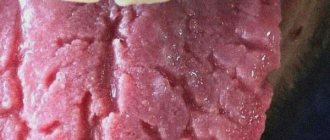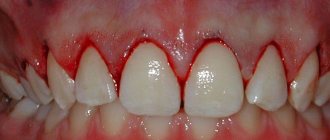Traumatologist-orthopedist
Shelepov
Alexander Sergeevich
13 years of experience
Doctor
Make an appointment
An accumulation of clots or liquid blood in the soft tissues of the body, formed due to rupture of blood vessels, is called a hematoma. The most common type of pathology is an ordinary bruise. However, this concept includes much more severe and complex cases that cannot be left without qualified medical care. Blood flowing from the vessel irritates the tissues surrounding it, resulting in pain, tissue swelling and other signs of developing inflammation. In addition, the hematoma compresses the tissues or organs located next to it, which can lead to the development of complications.
General information
The main cause of hematomas are bruises - closed injuries to soft tissues resulting from a blow or fall. A strong blow leads to rupture of the walls of small blood vessels, due to which blood begins to flow through the breakout sites into the subcutaneous tissue, soft tissues or body cavities. Hematomas form in different parts of the body - on the limbs, torso and even on the head. In addition to bruises, hematomas are caused by intense compression and stretching of tissues due to dislocations or fractures.
Small lesions, as a rule, do not require any treatment and resolve on their own within a few days. When large hematomas form, there is a risk of infection and the development of suppuration. Most often, hematomas form in representatives of younger age groups - children, adolescents and young people, who are characterized by high physical activity. Another “risk group” are people with increased fragility of the vascular wall, as well as with blood clotting disorders.
Gastrointestinal bleeding
Blood from the mouth may be accompanied by vomiting
Bleeding can occur in a variety of parts of the gastrointestinal tract. The main symptom is the appearance of blood in a person’s stool or vomit. It can be hidden and detected only with the help of specially conducted tests. In situations where blood from the mouth is caused by some kind of disease of the digestive system, it often goes along with vomiting.
In some cases, vomiting accompanied by slight bleeding may indicate a burst vessel in the throat or esophagus. But most often bleeding indicates the following diseases:
- stomach or duodenal ulcer
- erosion of the mucous membrane of the stomach or esophagus
- liver cirrhosis in severe stages
Ulcers provoke up to eighty cases of bleeding occurring in the gastrointestinal tract. In addition, due to bleeding, diseases such as enteritis, colitis, polyps, gastritis, duodenitis and others become aggravated. It also causes complications of cancer in any part of the digestive system.
The most severe form of blood effusion in the gastrointestinal tract is considered to be its loss through the veins of the esophagus, which occurs with portal hypertension. Sometimes severe bleeding occurs as a result of hemorrhoids. The use of certain medications in some situations causes the development of bleeding.
Why does a hematoma change color?
Doctors identify three distinct stages of a hematoma through which it must go before completely disappearing. Each of them is characterized by a certain skin color, through which the hemorrhage is visible.
- Appearance of a bruise. Immediately after a soft tissue bruise, a sharp pain is felt, the area of skin in the damaged area becomes purplish-red and swells due to tissue swelling, then the red color gradually changes to blue. The red color comes from red blood cells containing large amounts of hemoglobin. After a few hours, hemoglobin begins to break down, and the bruise site turns blue. Due to swelling and inflammation of the tissue in the damaged area, the temperature rises.
- Greening. After two or three days, swelling and temperature decrease, the condition of the tissues more or less returns to normal, but minor pain when pressed remains. The blue tint of the skin gradually turns into a greenish color.
- Yellowing. By about the fifth day, the swelling completely disappears, the remaining hemoglobin disintegrates and is removed from the tissues. The site of the bruise becomes yellowish, then acquires its normal color.
Visual symptoms of hematomas are most clearly visible in cases where the effusion of blood occurs in the subcutaneous layer. If a clot forms in the deeper layers of soft tissue, then only a small but painful swelling is noticeable on the outside. Such formations are much more dangerous, since the process occurs unnoticed and can be accompanied by complications.
Are you experiencing symptoms of a hematoma?
Only a doctor can accurately diagnose the disease. Don't delay your consultation - call
Hematoma on the tongue: causes
There are three reasons for a bruise on the tongue. If you determine the main one, the doctor will be able to prescribe competent treatment and the problem will disappear in the near future. Among the probable causes of hematoma, the following are worth highlighting.
- Injury to the mucous membrane by mechanical impact on it. Most often, the notorious fish bones and seed husks are to blame.
- Chemical burn. We are not talking about dangerous reagents, but the whole point is overly salted or spicy food. Pepper and salt irritate the delicate mucous membrane, thereby injuring it.
- Thermal exposure is a sip of scalding tea or an ice-cold drink. Most often, they provoke the appearance of hematomas on the tongue.
Types of damage
The faster a hematoma forms, the more difficult the recovery. Injuries of this type are divided into:
- lungs that develop within a day, accompanied by mild pain and not requiring special treatment;
- moderate severity, the appearance of which requires no more than 5-6 hours, accompanied by noticeable swelling and pain, worsening the motor function of the limb;
- severe, forming within 2 hours after a bruise, accompanied by dysfunction of the limb, acute pain and noticeable swelling.
Treatment of moderate and severe hematomas should be carried out under the supervision of a physician to eliminate possible negative consequences of injury.
In addition to the severity of the damage, there are other criteria for classifying hematomas:
- by depth of location - under the skin, under the mucous membrane, deep in the muscle tissue, under the fascia, etc.;
- according to the state of spilled blood - uncoagulated (fresh), coagulated and lysed (filled with old blood that is not capable of clotting);
- by the nature of blood distribution - diffuse (blood permeates the tissue and spreads quickly), cavitary (blood accumulates in the cavity between the tissues) and encysted (over time, the cavity filled with blood is surrounded by a “bag” of connective tissue);
- according to the condition of the vessel - pulsating (blood flows freely from the vessel and flows back) and non-pulsating (the rupture of the vessel is quickly sealed by a thrombus).
Almost always, hemorrhage poses a health hazard, so to eliminate its consequences, you need to seek medical help immediately after the injury.
What you should absolutely not do
If blood appears on the tongue, it means there is an open wound on its surface. In order not to aggravate the situation and not provoke the development of inflammatory processes, it is important to adhere to some restrictions. So, if you inadvertently injured the main speech organ, refrain from the following actions:
- cauterizing the wound with alcohol - this will only further injure the mucous membrane,
- drinking hot tea will increase bleeding,
- treating the wound with brilliant green or iodine,
- pressing the wound with a bare finger or teeth, trying to stop the bleeding by pressing the tongue to the roof of the mouth.
Until the bleeding has completely stopped, do not eat or put anything foreign in your mouth until the wound has completely healed. It is also strictly forbidden to self-medicate with antibacterial drugs - they can only be prescribed by the attending physician.
Examination methods
To diagnose hematomas, you need to contact a traumatologist. When the hemorrhage is localized deep in muscle tissue, joints or internal organs, a visual examination provides too little information for the doctor to objectively assess the severity of the lesion and the degree of danger of injury. In such situations, the patient is prescribed:
- Ultrasound of a damaged body part, organ or joint;
- X-ray of the damaged part of the body;
- CT or MRI;
- puncture (puncture with a special needle) of a joint or organ in which blood is believed to have accumulated.
Based on the examination results, the doctor prescribes appropriate procedures.
Treatment
Minor bruises can be treated conservatively: physiotherapeutic procedures and medications are prescribed.
In case of large accumulations of blood, the hematoma is treated surgically: it is opened, the blood or pus is evacuated, washed with antiseptics and drainage is installed. Antibiotics are prescribed if necessary.
When hemorrhaging into internal organs, it is often necessary to perform surgical intervention, during which it is necessary not only to remove the spilled blood, but also to stop the bleeding.
The multidisciplinary CELT clinic employs experienced traumatologists and surgeons who perform operations on hematomas of various locations. Modern techniques used in our clinic help provide effective treatment and minimize the risk of complications.
How to remove hematomas?
After establishing the nature and characteristics of the hematoma, treatment is prescribed in accordance with the information received:
- prescribe UHF procedures;
- a surgical opening is performed to remove accumulated clots and rinse the cavity;
- the patient is hospitalized in the surgical department for opening and drainage, followed by antibiotic therapy.
Recovery time depends on the extent of the lesion, the presence or absence of infection and other factors.
How to treat a blood bladder?
General therapy
Depending on the type of pathological condition that caused the appearance of a blood bubble in the mouth, treatment can be carried out with the following medications:
- In case of traumatic formations that go away on their own over time, the oral cavity is treated with antiseptic agents
For candidal stomatitis, antifungal drugs such as Levorin and Nystanin are effective.
- For diseases of viral etiology, the treatment regimen includes Viferon, Amoxicillin, Tsiprolet, Azithromycin.
- To combat gingivostomatitis, where it is expected to remove areas affected by necrosis, antiallergic medications, antibacterial agents, and vitamin complexes are used.
- In case of traumatic formations that go away on their own over time, the oral cavity is treated with antiseptic agents. If there is pain, the doctor may prescribe Cholisal, Ketoprofen, Voltaren, Lornoxicam, Kamistad.
- To eliminate tuberculosis, appropriate chemotherapy is prescribed, which includes Rifampicin, Ioniazid, Pyrazinamide.
Frequently asked questions
How to get rid of a hematoma using traditional methods?
Folk remedies only help with minor and non-dangerous superficial damage. To speed up resorption, you can apply a compress of mashed cabbage leaves, bodyagu mixed with Vaseline, or tampons soaked in a mummy solution to the bruise. For deep or extensive injuries, you should consult a doctor.
Why is a hematoma dangerous?
The greatest danger to health, and sometimes to life, are hematomas that form deep in the tissues, inside organs or joints. Large hemorrhage is dangerous due to the possible development of infection, inflammation and suppuration. If the joint is damaged, bursitis, synovitis or hemarthrosis may develop, resulting in disability. Blood in the peritoneal cavity leads to peritonitis. Brain hematomas lead to dysfunction of this organ with serious consequences in the form of deterioration of cognitive functions, paralysis of body parts, etc.
How to treat a hematoma in the first hours after injury?
Immediately after a bruise, it is necessary to provide first aid to the victim: apply ice to the injured area, then tightly bandage the injured limb to block the flow of blood into the tissue. The dressing should not remain on for more than two hours. During this time, it is necessary to get to the emergency room, where the patient will receive the necessary professional help.
Causes
Among the factors that provoke various external damage to the oral mucosa are:
Mechanical
Injury to the surface of the tongue is caused by all piercing and cutting objects that cause direct and instantly noticeable harm.
For example, dishes with bones cause damage to the oral mucosa during consumption. It is not the amount of food eaten that matters here, but the receipt of microtraumas that violate the integrity of the surface of the tongue.
Blood blisters that form due to mechanical action do not pose any threat to human health. To speed up the process of resorption of seals on the tongue, under it, it is recommended to rinse the mouth more often after eating.
Chemical
The duration of wound healing from thermal exposure directly depends on the depth of the lesion; they heal for quite a long time
When eating salty or sour food in the mouth, small lesions in the form of ulcers appear almost instantly on the mucous membrane of the tongue.
This reaction is observed among most fans of oriental cuisine, where hot seasonings are used.
Thermal
Such damage includes microtraumas resulting from drinking too hot tea or coffee.
The duration of wound healing from thermal exposure directly depends on the depth of the lesion; they take quite a long time to heal.
Depending on the degree of damage, sensations change:
- In the first degree, the burn occurs only on the outer layer of the tongue. A person experiences pain, the color of the tongue changes to red and after some time begins to swell. Rinsing the mouth with antiseptic solutions will help speed up the healing process.
- In the second degree , the sensations become more painful, since not only the outer but also the inner layer of the tongue is affected. The formation of blood blisters, swelling of the tongue and its redness are also observed. In this case, it is recommended to seek medical help as soon as possible so that the doctor removes the lump, washes the affected area and treats it with an antiseptic.
- In the third degree, the burn penetrates deep into the tongue, the burned surface becomes black. The patient complains of a feeling of numbness of the tongue and severe pain. The help of a doctor is mandatory here, otherwise there is a high probability of death.











